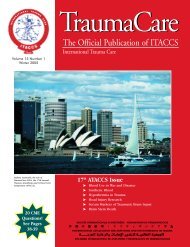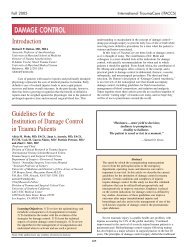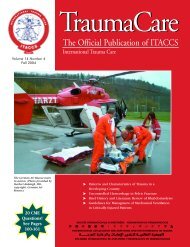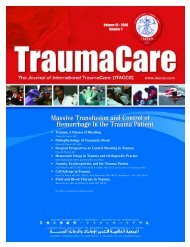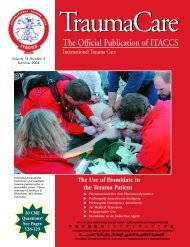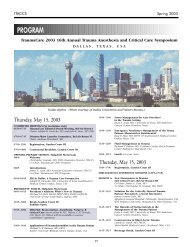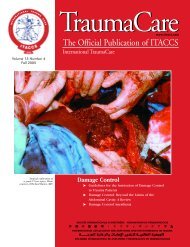Principles of Fluid and Blood Warming in Trauma.pdf - International ...
Principles of Fluid and Blood Warming in Trauma.pdf - International ...
Principles of Fluid and Blood Warming in Trauma.pdf - International ...
You also want an ePaper? Increase the reach of your titles
YUMPU automatically turns print PDFs into web optimized ePapers that Google loves.
Vol. 18, No. 1, 2008<strong>International</strong> <strong>Trauma</strong>Care (ITACCS)observations by Uhl <strong>and</strong> colleagues 26 <strong>and</strong> is supported by a largebody <strong>of</strong> experience with cardiac perfusion. In the study by Uhl etal, 26 red cells were <strong>in</strong>cubated at 37, 40, 42, 44, 46, 48, <strong>and</strong> 50°C forup to 2 hours <strong>in</strong> a constant-temperature waterbath. Even subtlealterations <strong>in</strong> red cell <strong>in</strong>tegrity such as <strong>in</strong>creased plasma hemoglob<strong>in</strong><strong>and</strong> osmotic fragility were not apparent until 46°C.Gore <strong>and</strong> Beaston 27 <strong>in</strong>fused hot crystalloid fluids dur<strong>in</strong>goperative burn wound debridement <strong>in</strong> an attempt to transfer heat tohypothermic patients. Temperature <strong>of</strong> crystalloid <strong>in</strong> their study was54°C, which would theoretically transfer approximately 21 kCal/L toa hypothermic patient whose core temperature is 33°C. Thistechnique was safe <strong>in</strong> their small series <strong>of</strong> patients undergo<strong>in</strong>g burnsurgery. There was no evidence <strong>of</strong> <strong>in</strong>travascular hemolysis, excessivebleed<strong>in</strong>g or hyperkalemia. 27Judk<strong>in</strong>s <strong>and</strong> Iserson 28 reported admixture blood warm<strong>in</strong>g <strong>in</strong>which very hot sal<strong>in</strong>e is mixed with cold red blood cells <strong>in</strong> order to<strong>in</strong>fuse normothermic blood. With this technique, 250 mL 0.9%sal<strong>in</strong>e, ma<strong>in</strong>ta<strong>in</strong>ed at a temperature <strong>of</strong> 70°C <strong>in</strong> an <strong>in</strong>cubator, isquickly added to the cold blood. The resultant admixture has atemperature <strong>of</strong> approximately 37°C without evidence <strong>of</strong> red blooddamage. 28,29Infusion <strong>of</strong> very hot fluids <strong>and</strong> admixture blood warm<strong>in</strong>g areconsidered experimental procedures. There is currently not enough<strong>in</strong>formation to recommend these techniques, <strong>and</strong> there is danger thatvery hot fluids may result <strong>in</strong> local vascular damage <strong>and</strong> hemolysis <strong>of</strong>cells. The maximum safe temperature for admixture blood warm<strong>in</strong>gis highly dependent on the relative volume <strong>of</strong> sal<strong>in</strong>e <strong>and</strong> blood. Use<strong>of</strong> unproven methods <strong>and</strong> unapproved approaches to warm<strong>in</strong>g fluids<strong>and</strong> blood can have catastrophic results, <strong>in</strong>clud<strong>in</strong>g death. 30,31<strong>Fluid</strong> <strong>and</strong> <strong>Blood</strong>-<strong>Warm<strong>in</strong>g</strong> DevicesSeveral methods to warm IV fluids <strong>and</strong> blood are currentlyavailable (Table 1). These <strong>in</strong>clude immers<strong>in</strong>g coiled IV tub<strong>in</strong>g <strong>in</strong> awarm water bath, microwav<strong>in</strong>g the bag <strong>of</strong> fluid to be <strong>in</strong>fused, add<strong>in</strong>gheated sal<strong>in</strong>e to blood to be <strong>in</strong>fused, pass<strong>in</strong>g the IV tub<strong>in</strong>g through aheat<strong>in</strong>g block or through a plastic tube warmed with forced air,pass<strong>in</strong>g the IV tub<strong>in</strong>g through a conductive surface <strong>in</strong>terfaced with acountercurrent heated water bath, magnetic <strong>in</strong>duction, prewarm<strong>in</strong>gfluids <strong>in</strong> a convection oven or <strong>in</strong> a microwave oven, <strong>and</strong> <strong>in</strong>l<strong>in</strong>emicrowav<strong>in</strong>g. 32–38The ideal fluid warmer should be capable <strong>of</strong> safely deliver<strong>in</strong>gfluids <strong>and</strong> blood products at normothermia at both high <strong>and</strong> low flowrates. At high flows, the device should be able to detect air <strong>and</strong>automatically shut <strong>of</strong>f to prevent accidental <strong>in</strong>fusion <strong>of</strong> air. Theability <strong>of</strong> blood warmers to safely deliver normothermic fluids overa wide range <strong>of</strong> flows is limited by several factors, <strong>in</strong>clud<strong>in</strong>g limitedheat-transfer capability <strong>of</strong> materials such as plastic, limited surfacearea <strong>of</strong> the heat exchange mechanism, <strong>in</strong>adequate heat transfer <strong>of</strong> theexchange mechanism at high flow rates, erythrocyte damage, <strong>and</strong>heat loss after the IV tub<strong>in</strong>g exits the warmer. 33,39–41<strong>Warm<strong>in</strong>g</strong> devices that use countercurrent heat exchange (Level1 fast flow H-1200; Smiths Medical, London, UK) <strong>and</strong> magnetic<strong>in</strong>duction (FMS 2000; Belmont Instrument Corp., Billerica, MA) arecapable <strong>of</strong> warm<strong>in</strong>g fluids even at very rapid flow rates because <strong>of</strong>better conduction materials <strong>in</strong>terposed between the heat<strong>in</strong>g elements<strong>and</strong> the <strong>in</strong>fused fluid (Figures 1-3; Table 2). 41–44 Moreover, both theFMS 2000 <strong>and</strong> Level 1 H-1200 <strong>in</strong>corporate safety features to preventaccidental <strong>in</strong>fusion <strong>of</strong> air (to be discussed <strong>in</strong> next section). Therefore,these warmers are appropriate for situations where rapid (>100mL/m<strong>in</strong>) volume resuscitation is necessary.At moderate flows (
<strong>International</strong> <strong>Trauma</strong>Care (ITACCS)www.itaccs.comFigure 3. Graphical <strong>in</strong>terface <strong>of</strong> the FMS 2000 show<strong>in</strong>g flow rate(RATE), volume <strong>in</strong>fused (VOL) temperature <strong>of</strong> the fluid distal to the heatexchanger (T), <strong>and</strong> l<strong>in</strong>e pressure (P). Flow rate is adjusted by press<strong>in</strong>gthe <strong>in</strong>crease or decrease rate button. Maximum unrestricted flow is 500mL/m<strong>in</strong>. However, flow is decreased automatically if l<strong>in</strong>e pressure is high(e.g., small-bore <strong>in</strong>travenous catheter). A fixed volume fluid bolus <strong>of</strong> 200mL can be automatically delivered. (From Smith CE, Kabbara A,Kramer RP, Gill I. A new IV fluid <strong>and</strong> blood warm<strong>in</strong>g system to preventair embolism <strong>and</strong> compartment syndrome. <strong>Trauma</strong>Care 2001;11:78–82.)as the Flotem IIe (Datachem Inc., Indianapolis, IN), ASTOTHERM(Stihler Electronic, Stuttgart, Germany; Figure 7), <strong>and</strong> others(<strong>in</strong>adequate heat transfer at high flows, significant <strong>in</strong>-l<strong>in</strong>e cool downat moderate <strong>and</strong> low flows), these devices are no longer <strong>in</strong> use at theauthor’s <strong>in</strong>stitution <strong>and</strong> have been replaced with the H-1025 (orH-1200) <strong>and</strong> FMS 2000 for rapid <strong>in</strong>fusion (>100 mL/m<strong>in</strong> or >6 L/hr)<strong>and</strong> the Hotl<strong>in</strong>e device for all other situations.Table 3 summarizes the implications <strong>of</strong> us<strong>in</strong>g various fluidwarmers dur<strong>in</strong>g commonly encountered cl<strong>in</strong>ical situations: pressuredriven<strong>in</strong>fusion, <strong>and</strong> gravity-driven <strong>in</strong>fusion with the roller clampwide open. 41,42 In the first situation, the patient presents with severecirculatory shock due to massive blood loss. <strong>Fluid</strong> resuscitation isrequired to prevent acidosis <strong>and</strong> irreversible shock. In the secondscenario, the fluid <strong>and</strong> blood-volume deficit is not as severe,although ongo<strong>in</strong>g blood loss may necessitate moderately fast<strong>in</strong>fusions with the roller clamp wide open to ma<strong>in</strong>ta<strong>in</strong> normovolemia<strong>and</strong> hemodynamic stability. It can be seen from the calculations <strong>in</strong>Table 3 that the thermal stress <strong>of</strong> <strong>in</strong>fus<strong>in</strong>g cold fluids may result <strong>in</strong>considerable changes <strong>in</strong> mean body temperature, especially if thepatient is unable to <strong>in</strong>crease heat production or prevent further heatloss. The larger the gradient between the temperature <strong>of</strong> the <strong>in</strong>fusedfluid <strong>and</strong> core temperature, the greater the drop <strong>in</strong> mean bodytemperature. As well, the greater the fluid requirement relative tobody weight, the greater the potential drop <strong>in</strong> body temperature.Table 2. Implications <strong>of</strong> Us<strong>in</strong>g <strong>Warm<strong>in</strong>g</strong> Devicesfor Crystalloid <strong>Fluid</strong> Resuscitation (5 <strong>and</strong> 10 L) <strong>in</strong> Anesthetized Adult <strong>Trauma</strong> Patients*Device Flow Rate Outlet Decrease <strong>in</strong> MBT† Decrease <strong>in</strong> MBT†(mL/m<strong>in</strong>) Temperature (°C) (5 L <strong>in</strong>fusion, °C) (10 L <strong>in</strong>fusion, °C)Flotem IIePressure 260 24 -1.12 -2.24Gravity 90 27 -1.03 -2.06AstothermPressure 260 25 -1.03 -2.06Gravity 90 30 -0.60 -1.20Bair Hugger 2.4.1Pressure 360 24.2 -1.10 -2.20Gravity 80 29.6 -0.63 -1.27Hotl<strong>in</strong>ePressure 220 29.8 -0.62 -1.24Gravity 80 34.8 -0.19 -0.38Level 1 250Pressure 600 33 -0.34 -0.69Gravity 290 36 -0.09 -0.17Level 1 H-1000Pressure 470 39.5 +0.22 +0.43Gravity 150 39.4 +0.21 +0.41FW537Pressure 580 38.9 +0.16 +0.32Gravity 200 39.9 +0.25 +0.49Cardioplegia Heat ExchangerPressure 700 35 -0.17 -0.34Gravity 150 35 -0.17 -0.34*See Table 1 for manufacturer <strong>in</strong>formation.†Change <strong>in</strong> mean body temperature (MBT) was calculated as (T F - T P ) x S F /Wt x S P where T F = temperature <strong>of</strong> fluid delivered to the patient (outlet temperature <strong>of</strong>the warmer), T P = temperature <strong>of</strong> the patient (assumed to be 37ºC), S F = specific heat <strong>of</strong> <strong>in</strong>fused fluid (1 kcal/1ºC crystalloid), S P = specific heat <strong>of</strong> the patient(0.83 kcal/1ºC). <strong>Fluid</strong>s were <strong>in</strong>fused dur<strong>in</strong>g two conditions: pressure-driven <strong>in</strong>fusion <strong>and</strong> gravity-driven <strong>in</strong>fusion with the roller clamp wide open.Data from refs. 41 <strong>and</strong> 42.74
Vol. 18, No. 1, 2008<strong>International</strong> <strong>Trauma</strong>Care (ITACCS)Figure 4, A <strong>and</strong> B. Level 1 H-1000 warmer (Smiths Medical, London,UK). The device consists <strong>of</strong> a cyl<strong>in</strong>drical alum<strong>in</strong>um heat exchangermounted on the warm<strong>in</strong>g unit <strong>and</strong> heated by a countercurrent water bathas <strong>in</strong> Figure 1. After the fluid exits this first heat exchanger, it enters a254-cm patient l<strong>in</strong>e <strong>in</strong> which heat loss is prevented by surround<strong>in</strong>g thecentral lumen with warmed water circulat<strong>in</strong>g <strong>in</strong> a countercurrentdirection, similar to the Hotl<strong>in</strong>e device. There is a double pneumaticexternal compressor that when activated, automatically squeezes the<strong>in</strong>travenous fluid or blood bag to <strong>in</strong>crease flow.Infusion <strong>of</strong> fluids prewarmed <strong>in</strong> a fluid-warm<strong>in</strong>g cab<strong>in</strong>et(Enthermics, Menomonee Falls WI; Fig 8) is also effective, providedthe fluid is kept <strong>in</strong> the cab<strong>in</strong>et for a sufficient time <strong>and</strong> <strong>in</strong>fused us<strong>in</strong>gunrestricted gravity flow with<strong>in</strong> 30 m<strong>in</strong>utes on removal from thecab<strong>in</strong>et. 38 Crystalloid fluid temperature is related to time <strong>in</strong> <strong>and</strong> timeout <strong>of</strong> the warm<strong>in</strong>g cab<strong>in</strong>et accord<strong>in</strong>g to the equations:1. T distal = T cab<strong>in</strong>et – (T cab<strong>in</strong>et – T room) * (1 – Exp (-ax))where,T distal = distal fluid temperatureT cab<strong>in</strong>et = temperature sett<strong>in</strong>g <strong>of</strong> the fluid warm<strong>in</strong>g cab<strong>in</strong>etT room = room temperaturea = coefficient (0.53 for 40°C cab<strong>in</strong>et, 0.46 for 42°C cab<strong>in</strong>et)x = time out <strong>of</strong> the cab<strong>in</strong>et (time exposed to room air).Figure 5, A <strong>and</strong> B. Hotl<strong>in</strong>e warmer (Smiths Medical, London, UK). Thedevice consists <strong>of</strong> a water bath <strong>and</strong> a 254-cm disposable patient l<strong>in</strong>e. Thecentral lumen for <strong>in</strong>travenous fluid is surrounded by an outer layerthrough which warm water circulates down one side <strong>and</strong> then back up tothe warm water reservoir <strong>in</strong> a countercurrent fashion (countercurrentheat-exchange technology).For example, if x is very short, T distal approaches that <strong>of</strong> T cab<strong>in</strong>et.As x <strong>in</strong>creases towards <strong>in</strong>f<strong>in</strong>ity, T distal approaches T room.And2. T distal = T room + (T cab<strong>in</strong>et – T room) * (1 – Exp (-ax)) where,T distal = distal fluid temperatureT cab<strong>in</strong>et = temperature sett<strong>in</strong>g <strong>of</strong> the fluid warm<strong>in</strong>g cab<strong>in</strong>etT room= room temperaturea = coefficient (0.52 for 40°C cab<strong>in</strong>et, 0.42 for 42°C cab<strong>in</strong>et)x = time <strong>in</strong> the cab<strong>in</strong>etFor example, if x is very short, T distal approaches T room. Asx approaches <strong>in</strong>f<strong>in</strong>ity, T distal approaches T cab<strong>in</strong>et.Figure 6, A <strong>and</strong> B. Belmont Buddy warmer (Belmont Instrument Corp.,Bellerica, MA). The disposable set is attached close to the patient tom<strong>in</strong>imize heat loss <strong>in</strong> the patient l<strong>in</strong>e. Prim<strong>in</strong>g volume is small (4 mL).The disposable set has microporous membranes that vent air fromcrystalloid fluid. Air is released through the side vents <strong>of</strong> the set tom<strong>in</strong>imize the risk <strong>of</strong> air embolism.Figure 7.Schematic <strong>of</strong>the Astothermwarmer (StihlerElectronic,Stuttgart,Germany).This deviceconsists <strong>of</strong><strong>in</strong>travenoustub<strong>in</strong>g coiledaround acircular heat<strong>in</strong>gelement(dry heattechnology).75
<strong>International</strong> <strong>Trauma</strong>Care (ITACCS)www.itaccs.comTable 3. <strong>Fluid</strong> <strong>and</strong> <strong>Blood</strong> <strong>Warm<strong>in</strong>g</strong> Us<strong>in</strong>g the Belmont FMS 2000 System*Flow rate Crystalloid Crystalloid Diluted Red <strong>Blood</strong> Cells Diluted Red <strong>Blood</strong> Cells(mL/m<strong>in</strong>) T proximal, ˚C T distal, ˚C T proximal, ˚C T distal, ˚CSlow10 37.3 (0.3) 28.9 (0.4) 33.3 (0.8) 22.6 (0.2)20 39.2 (0.4) 28.6 (0.2) 37.2 (0.8) 23.9 (0.8)30 39.5 (0.4) 28.8 (1.2) 38.4 (0.4) 28.9 (1.7)Moderate40 39.6 (0.4) 31.8 (1.2) 38.3 (0.5) 34.8 (1.2)50 38.8 (0.9) 32.1 (1.0) 38.9 (0.5) 33.9 (0.9)Rapid100 37.6 (0.3) 36.2 (0.6) 37.9 (0.9) 37.7 (0.5)200 38.3 (0.4) 37.4 (0.1) 37.5 (0.6) 35.0 (0.8)300 38.5 (0.8) 37.6 (0.2) 37.2 (0.6) 34.7 (0.6)400 38.6 (0.5) 37.5 (0.5) 37.3 (0.5) 35.4 (0.8)500 39.0 (0.3) 37.5 (0.3) 37.4 (1.1) 35.3 (3.0)*Temperature was measured after the heat exchanger (T proximal) <strong>and</strong> at the po<strong>in</strong>t where fluid would enter the patient (T distal). Refrigerated packed redblood cells were diluted with 100 mL 0.9% sal<strong>in</strong>e. Data are means (SD).Data from ref. 43The warm<strong>in</strong>g cab<strong>in</strong>et cannot be used for blood. Injection fluidsolution stability varies accord<strong>in</strong>g to temperature, duration <strong>of</strong> storageat that temperature, composition, <strong>and</strong> storage conta<strong>in</strong>er. Generally,fluids cannot be heated <strong>and</strong> stored longer than 14 days. Solutionwarm-up time varies depend<strong>in</strong>g on cab<strong>in</strong>et warmer load. Lau <strong>and</strong>Tsui 46 heated 1-liter bags <strong>of</strong> crystalloid <strong>in</strong> a microwave oven. Theyfound that it is possible to predict the rise <strong>in</strong> temperature based onthe power <strong>of</strong> the microwave <strong>and</strong> the set heat<strong>in</strong>g time. Theydeveloped a simple alogorithm as follows: temperature rise = 0.185x output (kW) x time (seconds), which can be used to calculate thetemperature rise <strong>of</strong> a 1-liter bag <strong>of</strong> fluid. Limit<strong>in</strong>g the heat<strong>in</strong>g time toless than 80 seconds prevented overheat<strong>in</strong>g. 46Figure 8. <strong>Fluid</strong> warm<strong>in</strong>g cab<strong>in</strong>et (EC770L, Enthermics Medical System,Menomonee Falls, WI). The cab<strong>in</strong>et is warmed to 42°C us<strong>in</strong>g a low-heatdensityelectrothermal cable array to provide even heat<strong>in</strong>g <strong>of</strong> <strong>in</strong>jectionfluids. Solution warm-up time varies depend<strong>in</strong>g on cab<strong>in</strong>et warmer load.The cab<strong>in</strong>et cannot be used to warm blood.Safety <strong>of</strong> Rapid Infusion Devices with Constant PressurePerioperative air embolism is a well-known complication <strong>of</strong>anesthesia <strong>and</strong> surgery. Symptoms <strong>and</strong> signs <strong>of</strong> air embolus <strong>in</strong>cludegasp, hypotension, arrhythmias, cardiovascular collapse, <strong>and</strong> death.Both the quantity <strong>of</strong> air <strong>and</strong> the rate at which it enters the circulationare important factors determ<strong>in</strong><strong>in</strong>g the severity <strong>of</strong> the embolic event.Accidental adm<strong>in</strong>istration <strong>of</strong> air <strong>in</strong> IV fluid bags dur<strong>in</strong>g use <strong>of</strong>pressurized <strong>in</strong>fusion devices can be fatal because <strong>of</strong> the rapidity <strong>of</strong>flow. Gas vent filter assemblies <strong>of</strong> many commercial fluid warmersact merely to release gas bubbles produced by the warm<strong>in</strong>g <strong>of</strong> theliquid. Amount <strong>of</strong> air that could reach the patient would then dependon factors such as drip chamber volume, air volume, gas vent <strong>and</strong>filter performance, temperature, <strong>and</strong> flow.L<strong>in</strong>den et al 47 showed <strong>in</strong> a simulated air- <strong>and</strong> fluid-conta<strong>in</strong><strong>in</strong>gadm<strong>in</strong>istration system such as <strong>in</strong> a fluid resuscitation model, that 43to 61 mL/sec <strong>of</strong> air can be delivered when the IV bag was externallypressurized to 300 mm Hg. This corresponds to as much as 200 mL<strong>of</strong> air enter<strong>in</strong>g the circulation <strong>in</strong> a little as 4 seconds, which is fatal.Because <strong>of</strong> the high flow rates generated by warmers when usedwith constant-pressure devices <strong>and</strong> large-bore IVs, the limit<strong>in</strong>g factor<strong>in</strong> fluid resuscitation is the time required to identify red cell donor<strong>and</strong> recipient <strong>in</strong>formation, to spike <strong>and</strong> hang the fluid, <strong>and</strong> to ensureabsence <strong>of</strong> air from the fluid system. In our experience, it is wise tohave one <strong>in</strong>dividual solely responsible for pressurized <strong>in</strong>fusion <strong>of</strong>fluids. This <strong>in</strong>dividual must use extreme vigilance <strong>and</strong> cautionbecause <strong>of</strong> the danger <strong>of</strong> <strong>in</strong>fus<strong>in</strong>g air at these high flow rates <strong>and</strong> thedanger <strong>of</strong> <strong>in</strong>terstitial <strong>in</strong>filtration <strong>of</strong> blood <strong>and</strong> sal<strong>in</strong>e (compartmentsyndrome). St<strong>and</strong>ard 1-liter bags <strong>of</strong> crystalloid conta<strong>in</strong> between 40<strong>and</strong> 85 mL <strong>of</strong> air. 45The authors are aware <strong>of</strong> seven cases <strong>of</strong> iatrogenic air embolism<strong>and</strong> two cases <strong>of</strong> forearm compartment syndrome follow<strong>in</strong>g use <strong>of</strong>pressurized IV <strong>in</strong>fusions. Adhikary <strong>and</strong> Massey 48 describe a case <strong>of</strong>massive venous air embolism dur<strong>in</strong>g coronary artery surgery thatoccurred while <strong>in</strong>fus<strong>in</strong>g crystalloid under pressure. Air embolismwas diagnosed us<strong>in</strong>g transesophageal echocardiography. Amanufacturer <strong>and</strong> user facility device experience (MAUDE) databaselists two cases <strong>of</strong> deaths dur<strong>in</strong>g pressurized <strong>in</strong>fusion <strong>of</strong> blood: one76
Vol. 18, No. 1, 2008<strong>International</strong> <strong>Trauma</strong>Care (ITACCS)after mitral valve replacement, the other dur<strong>in</strong>g <strong>in</strong>fusion to a majortrauma patient. The frequency <strong>of</strong> fatal air embolism after pressurizedadm<strong>in</strong>istration <strong>of</strong> cell saver blood was 4 <strong>of</strong> 127,586 blood recoveryprocedures, or 1:31,300. 47 In a letter to the editor to the AnesthesiaPatient Safety Foundation, mention is made <strong>of</strong> three cases <strong>of</strong>massive air embolism from pressure <strong>in</strong>fusers that resulted <strong>in</strong>settlements <strong>of</strong> $385,000 to $1,600,000 accord<strong>in</strong>g to the AmericanSociety <strong>of</strong> Anesthesiologists Closed Claims Study database. 49When <strong>in</strong>fus<strong>in</strong>g crystalloid under pressure, extra care must betaken to def<strong>in</strong>itively expel air prior to placement <strong>of</strong> any pressurized<strong>in</strong>fusion device, as human vigilance alone is <strong>in</strong>sufficient given thepossibility <strong>of</strong> rapid <strong>in</strong>fusion rates. Use <strong>of</strong> an automatic air detectorcoupled to an automatic shut-<strong>of</strong>f is desirable for rapid <strong>in</strong>fusiondevices. Pressurized <strong>in</strong>fusion <strong>of</strong> recovered blood (e.g., cell-saverblood) should be avoided because these bags may conta<strong>in</strong>considerable amounts <strong>of</strong> air <strong>and</strong> are difficult to vent.It is our belief that constant pressurized <strong>in</strong>fusion devices shouldnot be used to accelerate flow unless the patient is <strong>in</strong> pr<strong>of</strong>oundhemorrhagic shock <strong>and</strong> all air has been removed from the fluid to be<strong>in</strong>fused rapidly. The use <strong>of</strong> air bubble <strong>and</strong> l<strong>in</strong>e pressure sensors <strong>and</strong>alarms coupled with a shut-<strong>of</strong>f valve that automatically closes <strong>of</strong>f allflow to the patient is a dist<strong>in</strong>ct advantage <strong>of</strong> the FMS 2000 <strong>and</strong> H-1200 fluid warmers. The FMS 2000 elim<strong>in</strong>ates the risks normallyassociated with pressurized <strong>in</strong>fusion by us<strong>in</strong>g an <strong>in</strong>tegratedperistaltic pump together with several features that detect air beforeit enters the system (fluid-out detector), purge air that is out gasseddur<strong>in</strong>g warm<strong>in</strong>g (automatic air purge), <strong>and</strong> automatic shut-<strong>of</strong>f thatturns <strong>of</strong>f the pump as soon as air is detected or l<strong>in</strong>e pressure isexcessive (Figure 9; Table 4). 43,44With the H-1200, there is an air detector clamp that monitorsfor presence <strong>of</strong> air <strong>in</strong> the disposable gas vent-filter assembly (Figure10). 50 An ultrasound signal is cont<strong>in</strong>uously passed through the fluidfilledgas vent-filter assembly. Because a bolus <strong>of</strong> air displaces thefluid <strong>in</strong> the gas vent-filter assembly, the ultrasound signal is broken,<strong>and</strong> the clamp automatically closes <strong>of</strong>f the patient l<strong>in</strong>e. Audible <strong>and</strong>visual alarms are activated to alert the cl<strong>in</strong>ician that the fluid flowhas stopped because <strong>of</strong> the presence <strong>of</strong> air. The operator is thenprompted to follow a sequence <strong>of</strong> steps to purge the system <strong>of</strong> airbefore <strong>in</strong>fusion <strong>of</strong> fluids can be resumed. It should be noted that thesteps required to reprime the system with the Level 1 H-1200follow<strong>in</strong>g air detection <strong>and</strong> shut<strong>of</strong>f are very different from those <strong>of</strong>the Belmont FMS 2000. To restore flow after air detection with theFMS 2000, the operator follows a series <strong>of</strong> comm<strong>and</strong> prompts on thescreen, which result <strong>in</strong> the semiocclusive rollerhead pump push<strong>in</strong>g abolus <strong>of</strong> fluid to clear the air <strong>in</strong>to the recirculate l<strong>in</strong>e <strong>and</strong> back up<strong>in</strong>to the reservoir chamber. 43 With the Level 1 H-1200, multiple stepsare required to reestablish fluid flow after the patient l<strong>in</strong>e clamps <strong>of</strong>fbecause <strong>of</strong> air <strong>in</strong> the gas vent-filter assembly. The steps are asfollows 50 :1. Close the clamps under the IV bag, the roller clamp, <strong>and</strong>the clamp below the gas vent filter assembly.2. Remove pressure from the pressure chamber.3. Inspect the IV tub<strong>in</strong>g for air.4. Locate the air source <strong>and</strong> correct this condition.5. Spike an air free bag <strong>of</strong> 0.9% sal<strong>in</strong>e.6. Insert the IV bag <strong>in</strong> the pressure chamber.7. Pressurize the chamber.8. Prime the IV drip chamber <strong>and</strong> open the clamps above thegas vent-filter assembly.9. If fluid flows freely through the IV tub<strong>in</strong>g, air <strong>in</strong> the IVl<strong>in</strong>e is vented out through the gas vent-filter assembly.Figure 9. Belmont FMS 2000 disposable (Belmont Instrument Corp.,Bellerica, MA). The set consists <strong>of</strong> a 120-mL reservoir chamber, fluid-outdetector, pump tub<strong>in</strong>g, pressure chamber, recirculat<strong>in</strong>g l<strong>in</strong>e, <strong>and</strong> patientl<strong>in</strong>e. Total prim<strong>in</strong>g volume is 220 mL. There is redundant air detection,automatic air removal, <strong>and</strong> sensors to alert the operator when the systemis out <strong>of</strong> fluid, or a l<strong>in</strong>e is obstructed. (From Smith CE, Kabbara A,Kramer RP, Gill I. A new IV fluid <strong>and</strong> blood warm<strong>in</strong>g system to preventair embolism <strong>and</strong> compartment syndrome. <strong>Trauma</strong>Care 2001;11:78–82.)10. Press the unclamp button once to enter the unclamp mode11. Press the unclamp button aga<strong>in</strong> to enter automaticoperation mode12. If no warn<strong>in</strong>g signals are activated (e.g., no air detected,system primed <strong>and</strong> ready to go), open all clamps toreestablish fluid flow.If fluid does not flow freely through the IV tub<strong>in</strong>g <strong>in</strong> step 9, thegas vent-filter assembly needs to be replaced. Steps 1-8 are thenrepeated, followed by steps 10-12. Dur<strong>in</strong>g red cell <strong>in</strong>fusion with air(simulated air embolism catastrophe), it was not possible to purgethe Level 1 H-1200 disposable <strong>of</strong> air until the gas vent-filterassembly was removed from the unit. 50 Poor air vent<strong>in</strong>g performance<strong>of</strong> the gas-permeable membrane <strong>of</strong> the gas vent-filter assemblydur<strong>in</strong>g red cell <strong>in</strong>fusion may be due to prote<strong>in</strong>s plugg<strong>in</strong>g the filter.Failure to properly remove all air prior to reestablish<strong>in</strong>g flow,<strong>in</strong>clud<strong>in</strong>g replac<strong>in</strong>g <strong>and</strong> reprim<strong>in</strong>g the gas vent assembly, may result<strong>in</strong> accidental air embolism. Exist<strong>in</strong>g rapid <strong>in</strong>fusers by the samemanufacturer (H-1000/1025 <strong>and</strong> H-275/H-525) can be upgraded withthe <strong>in</strong>tegrated air detector/clamp device.77
<strong>International</strong> <strong>Trauma</strong>Care (ITACCS)www.itaccs.comTable 4. Time (seconds) to Automatically Shut Offdur<strong>in</strong>g Rapid Infusion Us<strong>in</strong>g theBelmont FMS 2000 <strong>Warm<strong>in</strong>g</strong> SystemFlow rate Time to Empty Time to Detect(mL/m<strong>in</strong>) 120 mL Reservoir Occluded 14-Gaugeafter AirIntravenousEntra<strong>in</strong>mentCatheter100 94.9 (0.9) 3.4 (0.9)200 47.2 (0.8) 2.4 (0.6)300 34.6 (1.5) 1.4 (0.2)400 30.8 (0.8) 0.9 (0.2)Data are mean values (SD).Data from ref. 43.<strong>Fluid</strong> <strong>Warm<strong>in</strong>g</strong> <strong>and</strong> Pediatrics<strong>Trauma</strong> is a disease that is not limited to adults. The pediatricpopulation encounters many <strong>of</strong> the same issues as do adults withregard to hypothermia <strong>and</strong> hemorrhagic shock. Moreover,hypovolemia can be relatively more severe as children have a lowertotal blood volume than adults. Both the Hotl<strong>in</strong>e <strong>and</strong> Buddy fluidwarmers provide warm<strong>in</strong>g mechanisms close to the distal end <strong>of</strong> theIV l<strong>in</strong>e. This m<strong>in</strong>imizes heat loss before the fluid enters the ve<strong>in</strong>, atall but the slowest <strong>of</strong> flows. 33,42,45 The Buddy disposable set hasmicroporous membranes that vent air from crystalloid fluid. Air isreleased through the side vents <strong>of</strong> the set. Use <strong>of</strong> this warm<strong>in</strong>gdevice might theoretically reduce the risk <strong>of</strong> accidental <strong>in</strong>fusion <strong>of</strong>air dur<strong>in</strong>g crystalloid resuscitation <strong>of</strong> pediatric patients. 45 The Buddydisposable does not, however, vent air dur<strong>in</strong>g red blood cell <strong>in</strong>fusion.The Hotl<strong>in</strong>e warmer does not have a mechanism for vent<strong>in</strong>g <strong>of</strong> air.The Hotl<strong>in</strong>e disposable tub<strong>in</strong>g is <strong>in</strong>convenient for use <strong>in</strong> neonates<strong>and</strong> <strong>in</strong>fants because <strong>of</strong> its relatively bulky size <strong>and</strong> large prim<strong>in</strong>gvolume. Of note, the FMS 2000 is unable to heat fluids at flows lessthan 10 mL/m<strong>in</strong>, <strong>and</strong> is therefore not recommended for pediatrics.Serour et al 51 found that putt<strong>in</strong>g an IV l<strong>in</strong>e under a warm<strong>in</strong>g mattresswas a good fluid-warm<strong>in</strong>g method, <strong>and</strong> was superior than theirconventional fluid warmer because it prevented heat loss before thefluid entered the vien. Tseng et al 52 showed that simple wrapp<strong>in</strong>g <strong>of</strong>the IV tub<strong>in</strong>g with superlon (which is an <strong>in</strong>sulat<strong>in</strong>g foam rubber thatis used to prevent heat exchange <strong>in</strong> air conditioners) ma<strong>in</strong>ta<strong>in</strong>s heatdistal to the warmer prevent<strong>in</strong>g <strong>in</strong>-l<strong>in</strong>e cool down.SummaryAdverse consequences <strong>of</strong> perioperative hypothermia <strong>in</strong>cludemyocardial ischemia, cardiac arrhythmias, coagulopathy, shiver<strong>in</strong>g,<strong>in</strong>creased oxygen consumption dur<strong>in</strong>g rewarm<strong>in</strong>g, alteration <strong>in</strong> drugmetabolism, impaired <strong>of</strong>fload<strong>in</strong>g <strong>of</strong> oxygen from hemoglob<strong>in</strong>, <strong>and</strong><strong>in</strong>creased wound <strong>in</strong>fection. Adm<strong>in</strong>istration <strong>of</strong> cold or <strong>in</strong>adequatelywarmed IV fluids contributes to hypothermia, whereasadm<strong>in</strong>istration <strong>of</strong> normothermic fluids may reduce both the <strong>in</strong>cidence<strong>and</strong> complications <strong>of</strong> hypothermia. Therefore, <strong>in</strong>fusion <strong>of</strong> adequatelywarmed fluids is important <strong>in</strong> order to m<strong>in</strong>imize thermal stress <strong>and</strong>ma<strong>in</strong>ta<strong>in</strong> thermal homeostasis. The choice <strong>of</strong> fluid warmer dependson patient needs, heat-transfer capabilities <strong>of</strong> the warmer, amount <strong>of</strong><strong>in</strong>-l<strong>in</strong>e cool down expected, operator preference, <strong>and</strong> safetycharacteristics. There is no one ideal fluid warmer for use <strong>in</strong> allpatients.ReferencesFigure 10. Level 1 H-1200 with <strong>in</strong>tegrated air detector/clamp (SmithsMedical, London, UK). The device consists <strong>of</strong> a heater that warms water<strong>and</strong> circulates it through a pump <strong>and</strong> a heat-exchange segment with acentral tube (1) for water flow as <strong>in</strong> Figure 1 (countercurrent heatexchange technology). On detection <strong>of</strong> air <strong>in</strong> the l<strong>in</strong>e, the flow <strong>of</strong> blood<strong>and</strong> crystalloid is automatically stopped (3), allow<strong>in</strong>g for removal <strong>of</strong> air<strong>and</strong> restoration <strong>of</strong> flow. There are audible <strong>and</strong> visual alarms when air isdetected. The use <strong>of</strong> ultrasonic air detection coupled with automaticshut<strong>of</strong>f is a significant safety improvement.1. Smith CE, Soreide E. Hypothermia <strong>in</strong> trauma victims. American Society <strong>of</strong>Anesthesiologists’ Newsletter 2005;69(11):17-9.2. Danzl DF, Pozos RS. Accidental hypothermia. N Engl J Med 1994;331:1756-60.3. Luna GK, Maier RV, Pavl<strong>in</strong> EG, et al. Incidence <strong>and</strong> effect <strong>of</strong> hypothermia<strong>in</strong> seriously <strong>in</strong>jured patients. J <strong>Trauma</strong> 1987;27:1014-8.4. Jurkovich GJ, Greiser WB, Luterman A, Curreri PW. Hypothermia <strong>in</strong> traumavictims: an om<strong>in</strong>ous predictor <strong>of</strong> survival. J <strong>Trauma</strong> 1987;27:1019-24.5. Gregory JS, Flancbaum L, Townsend MC, Cloutier CT, Jonasson O.Incidence <strong>and</strong> tim<strong>in</strong>g <strong>of</strong> hypothermia <strong>in</strong> trauma patients undergo<strong>in</strong>goperations. J <strong>Trauma</strong> 1991;31:795-800.6. Pavl<strong>in</strong> EG. Hypothermia <strong>in</strong> traumatized patients. In Gr<strong>and</strong>e CM, ed.Textbook <strong>of</strong> <strong>Trauma</strong> Anesthesia <strong>and</strong> Critical Care. St. Louis, Mosby-YearBook, 1993:1131-9.7. Little RA, Stoner HB. Body temperature after accidental <strong>in</strong>jury. Br J Surg1981;68:221-4.8. Sessler DI. Mild perioperative hypothermia. N Engl J Med 1997; 336:1730-7.9. Helm M, Lampl L, Hauke J, Bock KH. Accidental hypothermia <strong>in</strong> traumapatients. Is it relevant to precl<strong>in</strong>ical emergency treatment? [<strong>in</strong> Germann].Anaesthesist 1995;44:101-7.10. Wang HE, Callaway CW, Peitzman AB, Tisherman SA. Admissionhypothermia <strong>and</strong> outcome after major trauma. Crit Care Med 2005; 33:1296-30111. Tsuei BJ, Kearney PA. Hypothermia <strong>in</strong> the trauma patient. Injury 2004;35:7-15.12. Sessler DI. Temperature monitor<strong>in</strong>g. In: Miller RD, ed. Anesthesia, 6th ed.New York: Churchill Liv<strong>in</strong>gstone, 2005:1571-97.13. Krishna G, Sleigh JW, Rahman H. Physiological predictors <strong>of</strong> death <strong>in</strong>exsangu<strong>in</strong>at<strong>in</strong>g trauma patients undergo<strong>in</strong>g conventional trauma surgery.Aust N Z J Surg 1998;68:826-9.14. Smith CE, Patel N. Hypothermia <strong>in</strong> adult trauma patients: Anestheticconsiderations. Part 1, Etiology <strong>and</strong> Pathophysiology. Am J Anesthesiol1996;23:283-90.78
Vol. 18, No. 1, 2008<strong>International</strong> <strong>Trauma</strong>Care (ITACCS)15. Kurz A, Sessler DI, Lenhardt R. Perioperative normothermia to reduce the<strong>in</strong>cidence <strong>of</strong> surgical wound <strong>in</strong>fection <strong>and</strong> shorten hospitalization.N Engl J Med 1996;334:1209-15.16. Sessler DI. Consequences <strong>and</strong> treatment <strong>of</strong> perioperative hypothermia.Anesth Cl<strong>in</strong> North Am 1994;12:425-56.17. Watts DD, Trask A, Soeken K, et al. Hypothermic coagulopathy <strong>in</strong> trauma:effect <strong>of</strong> vary<strong>in</strong>g levels <strong>of</strong> hypothermia on enzyme speed, platelet function,<strong>and</strong> fibr<strong>in</strong>olytic activity. J <strong>Trauma</strong> 1998;44:846-54.18. Frank SM, Higg<strong>in</strong>s MS, Breslow MJ, et al. The catecholam<strong>in</strong>e, cortisol, <strong>and</strong>hemodynamic responses to mild perioperative hypothermia. Anesthesiology1995;82:83-9.19. Frank SM, Fleisher LA, Breslow MJ, et al. Perioperative ma<strong>in</strong>tenance <strong>of</strong>normothermia reduces the <strong>in</strong>cidence <strong>of</strong> morbid cardiac events: ar<strong>and</strong>omized cl<strong>in</strong>ical trial. JAMA 1997;227:1127-34.20. Boyan CP, Howl<strong>and</strong> WS. <strong>Blood</strong> temperature: a critical factor <strong>in</strong> massivetransfusion. Anesthesiology 1961;22:559-63.21. Boyan CP, Howl<strong>and</strong> WS. Cardiac arrest <strong>and</strong> temperature <strong>of</strong> bank blood.JAMA 1963;183:58-60.22. Boyan CP. Cold or warmed blood for massive transfusions. Ann Surg1964;160:2882-6.23. Mendlowitz M. The specific heat <strong>of</strong> human blood. Science 1948;107:97.24. Gentilello LM, Cortes V, Moujaes S, et al. Cont<strong>in</strong>uous arteriovenousrewarm<strong>in</strong>g: experimental results <strong>and</strong> thermodynamic model simulation <strong>of</strong>treatment for hypothermia. J <strong>Trauma</strong> 1990;30:1436-49.25. Dubois EF. Basal Metabolism <strong>in</strong> Health <strong>and</strong> Disease. Philadelphia, Lee <strong>and</strong>Febiger, 1924:324.26. Uhl L, Pac<strong>in</strong>i DG, Kruskall MS. The effect <strong>of</strong> heat on <strong>in</strong> vitro parameters <strong>of</strong>red cell <strong>in</strong>tegrity. Transfusion 1993;33:60S.27. Gore DC, Beaston J. Infusion <strong>of</strong> hot crystalloid dur<strong>in</strong>g operative burnwound debridement. J <strong>Trauma</strong> 1997;42:1112-5.28. Judk<strong>in</strong>s D, Iserson KV. Rapid admixture blood warm<strong>in</strong>g. J Emerg Nurs1991;17:146-51.29. Wilson EB, Knauf MA, Donohoe K, Iserson KV. Red blood cell survivalfollow<strong>in</strong>g admixture with heated sal<strong>in</strong>e: evaluation <strong>of</strong> a new blood warm<strong>in</strong>gmethod for rapid transfusion. J <strong>Trauma</strong> 1988;28:1274-7.30. Sazama K. Reports <strong>of</strong> 355 transfusion-associated deaths: 1976 through1985. Transfusion 1990;30:583-90.31. Rososhansky S, Szymanski I. Is blood warm<strong>in</strong>g before transfusion a safeprocedure? Anesth Analg 1994;79:197-8.32. Uhl L, Pac<strong>in</strong>i D, Kruskall MS. A comparative study <strong>of</strong> blood warmerperformance. Anesthesiology 1992;77:1022-8.33. Presson RG, Bezruczko AP, Hillier SC, McNiece WL. Evaluation <strong>of</strong> a newfluid warmer effective at low to moderate flow rates. Anesthesiology1993;78:974-80.34. Patel N, Smith CE, P<strong>in</strong>chak AC, Hagen JF: Prospective, r<strong>and</strong>omizedcomparison <strong>of</strong> the Flotem IIe <strong>and</strong> Hotl<strong>in</strong>e fluid warmers <strong>in</strong> anesthetizedadults. J Cl<strong>in</strong> Anesth 1996;8:307-16.35. Smith CE, Holbrook C, Radesic B, et al. Comparison <strong>of</strong> perioperativeheat<strong>in</strong>g modalities <strong>in</strong> anesthetized adult patients: a prospective r<strong>and</strong>omizedstudy. Am J Anesthesiol 1998;25:62-8.36. Smith CE, Desai R, Glorioso V, et al. Prevent<strong>in</strong>g hypothermia: convective<strong>and</strong> <strong>in</strong>travenous fluid warm<strong>in</strong>g versus convective warm<strong>in</strong>g alone.J Cl<strong>in</strong> Anesth 1998;10:380-5.37. Smith CE, Patel N. Hypothermia <strong>in</strong> adult trauma patients: anestheticconsiderations. Part II: prevention <strong>and</strong> treatment. Am J Anesthesiol1997;24:29-36.38. Raymond C, Kroll A, Smith CE. <strong>Warm<strong>in</strong>g</strong> crystalloid fluid for <strong>in</strong>travenous<strong>in</strong>fusion: how effective is a fluid warm<strong>in</strong>g cab<strong>in</strong>et? MetroHealth ResearchFestival, September 200539. Fildes J, Fisher S, Sheaff CM, Barrett JA. Effects <strong>of</strong> short heat exposure onhuman red <strong>and</strong> white blood cells. J <strong>Trauma</strong> 1998;45:479-84.40. Herron DM, Grabowy R, Connolly R, Schwaitzberg SP. The limits <strong>of</strong>bloodwarm<strong>in</strong>g: maximally heat<strong>in</strong>g blood with an <strong>in</strong>l<strong>in</strong>e microwavebloodwarmer. J <strong>Trauma</strong> 1997;43:219-26.41. Patel N, Smith CE, P<strong>in</strong>chak AC. Comparison <strong>of</strong> fluid warmer performancedur<strong>in</strong>g simulated cl<strong>in</strong>ical conditions. Can J Anaesth 1995;42:636-42.42. Patel N, Knapke DM, Smith CE, et al. Simulated cl<strong>in</strong>ical evaluation <strong>of</strong>conventional <strong>and</strong> newer fluid warm<strong>in</strong>g devices. Anesth Analg 1996;82:517-24.43. Smith CE, Kabbara A, Kramer RP, Gill I. A new IV fluid <strong>and</strong> bloodwarm<strong>in</strong>g system to prevent air embolism <strong>and</strong> compartment syndrome.<strong>Trauma</strong>Care 2001;11:78-82.44. Comunale ME. A laboratory evaluation <strong>of</strong> the Level 1 rapid <strong>in</strong>fuser(H1025) <strong>and</strong> the Belmont Instrument fluid management system (FMS 2000)for rapid transfusion. Anesth Analg 2003;97:1064-9.45. Avula RR, Smith CE. Air vent<strong>in</strong>g <strong>and</strong> <strong>in</strong>-l<strong>in</strong>e <strong>in</strong>travenous fluid warm<strong>in</strong>g forpediatrics. Anesthesiology 2005;102:1290.46. Lau B, Tsui B. A simple calculation for warm<strong>in</strong>g sal<strong>in</strong>e us<strong>in</strong>g a microwave.Can J Anesth 2004;51:A5.47. L<strong>in</strong>den JV, Kaplan HS, Murphy MT. Fatal air embolism due toperioperative blood recovery. Anesth Analg 1997;84:422-6.48. Adhikary GS, Massey SR. Massive air embolism: a case report.J Cl<strong>in</strong> Anesth 1998;10:70-2.49. Comunale ME. IV fluid warmers create air embolus danger. AnesthesiaPatient Safety Foundation Newsletter 2000;15(3):41-2.50. Avula RR, Kramer R, Smith CE. Air detection performance <strong>of</strong> the Level1H-1200 fluid <strong>and</strong> blood warmer. Anesth Analg 2005;101:1413-6.51. Serour F, Weissenberg M, Boaz M, Ezri T, Gorenste<strong>in</strong> A. Intravenous fluidswarm<strong>in</strong>g by mattress is simple <strong>and</strong> efficient dur<strong>in</strong>g pediatric surgery.Acta Anaesthesiol Sc<strong>and</strong> 2002;46:80-4.52. Tseng CC, Su HB, Yeh FC, et al. Shorten<strong>in</strong>g <strong>and</strong> superlon-wrapp<strong>in</strong>g thedownstream tube can <strong>in</strong>crease the useful range <strong>of</strong> the blood warmer.Acta Anaesthesiol Sc<strong>and</strong> 1996;34:123-8.79




